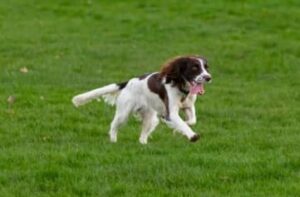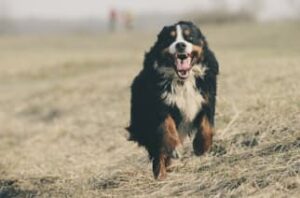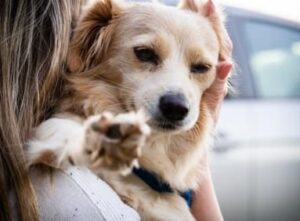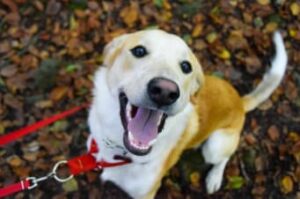Most professional dog walkers, although better informed than an average owner, aren’t dog trainers. Training a behaviour, like recall, takes time and needs consistency from everyone who interacts with the dog. But there are some tips and tricks to manage recall even in a dog you only see once a week.
- Have a process you follow for all new dogs to assess their level of recall
- Increase your own value in the dog’s eyes
- Know what to do if they don’t come back
Table of Contents
What is recall?
Recall is simply when you call a dog’s name or use another cue such as a whistle, and the dog comes running back to you no matter what they’re doing.
Most family dogs who are allowed off lead will have a basic level of recall (or should!) which means that they will return in a low distraction environment without too much trouble.
But add in a distraction, a squirrel, another dog, a picnic, and their recall fails.

Recall process for new clients
Disbelieve the client
Clients aren’t lying to you. When their dog is with them on a walk their recall may be great. The dog has a bond, a relationship build up over the years and the owner has value for the dog. The dog has a reason to come back.
With you however, they don’t have that bond, no history of being reinforced for coming back and on top of all that you may have taken them somewhere they don’t normally walk, with other dogs they don’t normally meet.
Short lead and bond
If you can, do a couple of solo walks before adding a new dog to the groups. This will give you a chance to bond with a dog and get to know them. You’ll also get a sense of which other dogs you feel they’ll get along with and enjoy being on a group walk with.
During these solo walks you can start using a normal length lead, and during the walk call their name, get their attention and reward them with a treat. The treat raises your value to the dog and it gives them a reason to pay attention next time.
Once the dog is responding every time you ask for attention you can progress to a long line.
Longline
This is a really long lead essentially. You should always attach it to a harness, not a collar, in order to protect their neck.
You repeat the process you practiced with a short lead but you start to allow the dog more freedom by giving them a longer length of lead.
So to start with you might keep the lead to around 2 metres, call them back, reward then let them go back to walking and sniffing.
Then, if they’re still responding to you, let them have 3 metres and practice, then 4 metres, then however long your lead is.
This enables you to practice recall without risking a runaway dog.
Trailing long line
The next stage is to allow the long line to trail behind the dog. Practice recalling the dog and rewarding whilst they still have the line attached. If you need to get them back quickly, you still have the opportunity to grab the end of the trailing lead or step on it to stop it sharply (Hence we attach it to a harness and not a collar).
Off lead
Once a dog repeatedly responds well with a trailing longline you can let them offlead on your walks.
This process might happen over the course of one, 1-hour walk, or you may have to do several walks before the dog learns what to do.
If your new dog is friendly, and your own dog is well trained, taking them out together can be a massive help. When calling your own dog back to you the other dog(s) tend to follow, especially if they see treats being handed out!

Value
As mentioned earlier, when you take on a new client you will have zero value to that dog at first. They don’t know you, don’t recognise you or associate you with anything. But there are ways you can increase your value to that dog.
If you run a dog walking company with several walkers, try and send the same walker each time. The dogs will learn the sound of the vehicle and associate the person walking them with having a good experience. That walker will start to rise in value to the dog.
Using food to reward good behaviour massively increases your value to a dog. Dogs need to eat to survive so the value given by them to food is naturally motivating to dogs, that’s why we use it in training so much.
A firm favourite and a less risky option for dogs with allergies or special diets are dried sprats. Fish is rarely a protein dogs are allergic to, there are no additives and they’re low fat.
Other dogs can be a great way to increase your own value. If you have a group walk where all the dogs recall fantastically, then popping the new dog in with that group will show him that coming back to you when called has value. If everyone else runs back to you then he’s likely to follow them too.
What to do if your dog doesn’t come back?
If you can see the dog and they’re just distracted by something else or running away as you approach them;
Stop and drop.
If you have their attention, stop and drop to the floor. An inquisitive dog will come over and investigate why you’re lying on the ground.
Food.
If you’re walking with a group then crack open the treat bag and start feeding everyone. Your runaway might just come over and join in.
Squeak
I pack the squeaker from a squeaky toy in my walking bag. It helps to get everyone’s attention, especially the terriers! Give it a squeak and maybe he’ll come running.
Dogs
If you’re walking them as a solo walk, find a friendly walker with a dog to help. Dogs attract dogs so if they see you suddenly fussing another dog they may come over.
Use your own dog or a dog you know has great recall. Throw a ball in the other dog’s direction and get your dog to go and retrieve it. The other dog might engage and come back.

If you can’t see the dog;
- Stop
Lost and runaway dogs often follow their own scent back to you. It’s hard not to rush off looking for your dog but it’s likely they’ll return to the place you lost them.
2. Call for help
Because you need to stay where you are you’re going to need help to look around the area. Ask passers-by if you’re in a park, or call a colleague you network with. We’ve all been there and are only too happy to help if you lose one of yours.
3. Don’t panic
Don’t do anything for 10 minutes. See if they come back of their own accord. See if passers-by have seen the dog. Don’t call the owner. Don’t post a lost dog post on your Facebook page. Give it a few minutes.
4. After ten minutes
Hopefully, you have help on the way by now. If the dog lives nearby have someone check the route between where you are and their house, dogs often follow their noses and one in four dogs are found this way.
Check your phone for calls in case someone’s found your dog and has called your business dog tag
Check local Facebook groups to see if anyone’s found and posted a photo of your dog..
5. After twenty minutes
Call the local dog warden (you’ll find the number on the council website, save it in your phone now while you’re thinking about it) and the nearest vets (again, why not save all the numbers in your phone now) to see if they’ve been handed in.
Take a deep breath and call the owner to let them know.
Conclusion
Losing a dog, even for a minute, is a gut-wrenching experience. I’ve lost two dogs during my time as a dog walker and both were found within 10 minutes, no further than 500 metres from where I’d misplaced them. Both times they were just nearby, I looked away for a second, and they had disappeared.
Building value, using rewards and ensuring the dog has earned the right to be off-lead by following the process above will dramatically reduce incidents like this. But if they do happen, make sure you’re prepared.
AFFILIATE DISCLAIMER
The dog walking coach website is supported by our visitors. Some of the product links on this website are through affiliate schemes such as Amazon. This means that I earn a small commission if you choose to purchase something at no extra cost to yourself.
